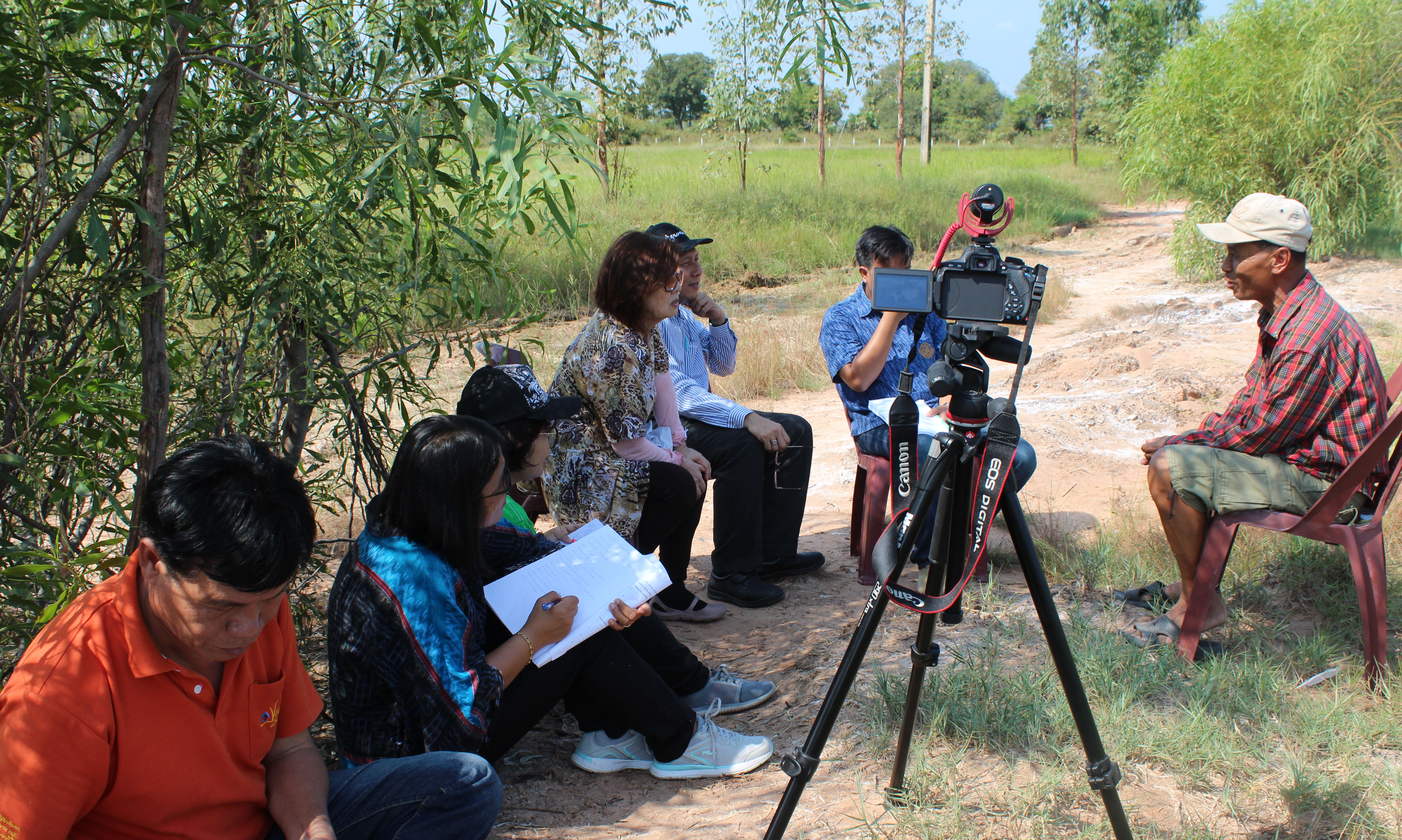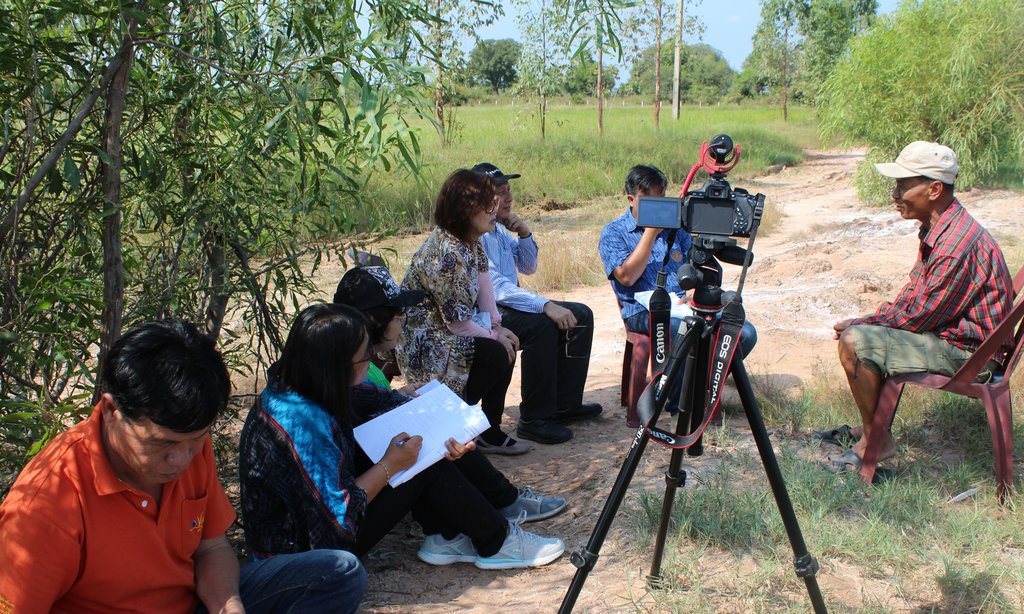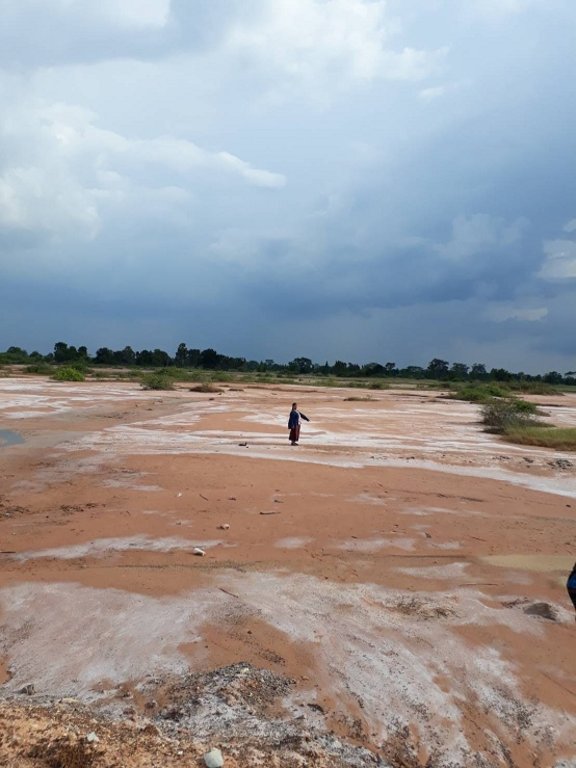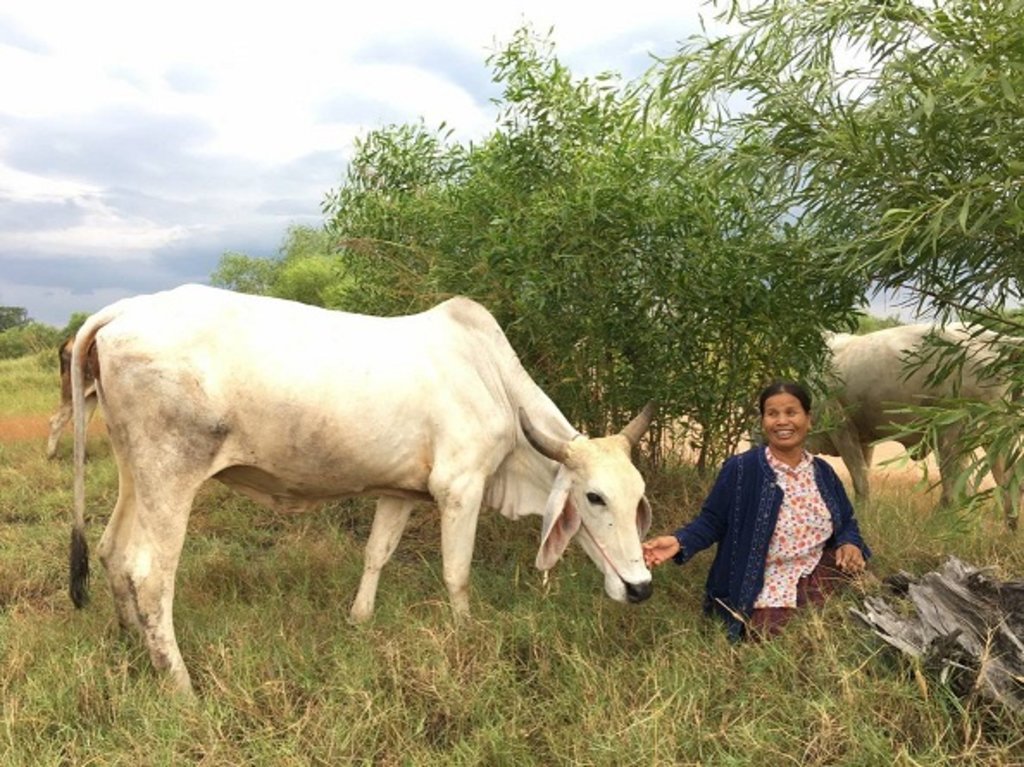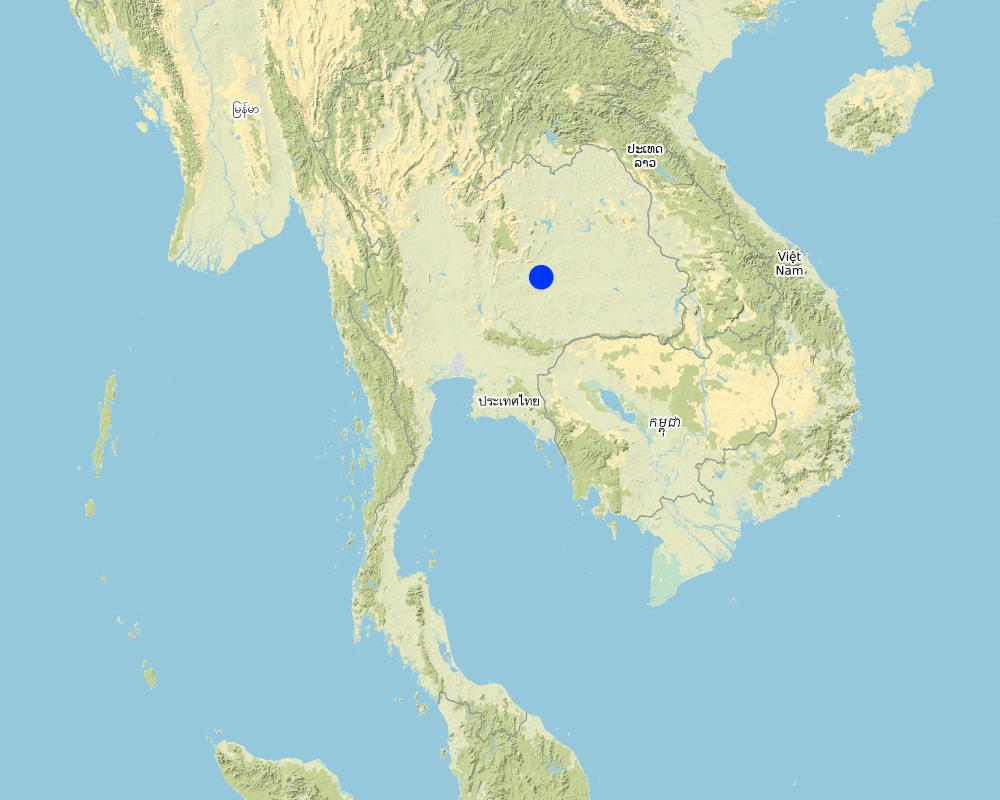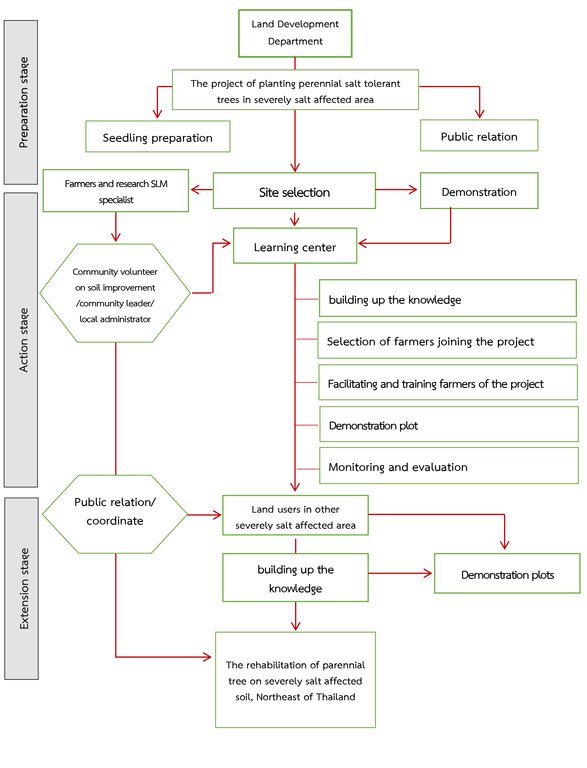Promotion of Acacia ampliceps on severely salt-affected soil [ໄທ]
- ການສ້າງ:
- ປັບປູງ:
- ຜູ້ສັງລວມຂໍ້ມູນ: Phatranit Chuaysanoi
- ບັນນາທິການ: –
- ຜູ້ທົບທວນຄືນ: Samran Sombatpanit, Rima Mekdaschi Studer, William Critchley
Planting Acacia ampliceps on severely salt-affected land.
approaches_4203 - ໄທ
ເບິ່ງພາກສ່ວນ
ຂະຫຍາຍທັງໝົດ ຍຸບທັງໝົດ1. ຂໍ້ມູນທົ່ວໄປ
1.2 ລາຍລະອຽດ ການຕິດຕໍ່ ຂອງບຸກຄົນທີ່ຊັບພະຍາກອນ ແລະ ສະຖາບັນ ການມີສ່ວນຮ່ວມ ໃນການປະເມີນຜົນ ແລະ ເອກະສານ ຂອງວິທີທາງ
ຜູ້ນໍາໃຊ້ທີ່ດິນ:
Tathaisong Nurean
+66-62-1521591
-
25 Ban Kok Sa-ard, Moo 10, T. Danchang, A. Buayai, Nakhon Ratchasima, Thailand
ໄທ
ຜູ້ນໍາໃຊ້ທີ່ດິນ:
Panikom Chartee
+66-85-4395414
-
136/1 Moo 2, T. Danchang, A. Buayai, Nakhon Ratchasima
ໄທ
ຜູ້ນໍາໃຊ້ທີ່ດິນ:
Salanok Mongkoen
+66-98-1181365
-
184 Moo 2, T. Danchang, A. Buayai, Nakhon Ratchasima
ໄທ
ຜູ້ນໍາໃຊ້ທີ່ດິນ:
Palinee TubseKaew
+66-87-8706265
-
275 Moo 9, T. Danchang, A. Buayai, Nakhon Ratchasima
ໄທ
Soil doctor volunteer:
Ponrat Kumpu
+66-85-6308129
-
106 Moo 9, T. Danchang, A. Buayai, Nakhon Ratchasima
Assistant of village leader:
Pawanna Pakorn
+66-86-2586926
-
34 Moo 9, T. Danchang, A. Buayai, Nakhon Ratchasima
ຜູ້ຊ່ຽວຊານ ດ້ານການຄຸ້ມຄອງ ທີ່ດິນແບບຍືນຍົງ:
Phaosrakhu Chakkaphan
+66-44-371397
yom42@hotmail.com
Technical Group for Land Development, Land Development Regional Office 3, Land Development Department
64 Moo 7, T. Joho, A. Muang, Nakhon Ratchasima 30310
ໄທ
ຜູ້ຊ່ຽວຊານ ດ້ານການຄຸ້ມຄອງ ທີ່ດິນແບບຍືນຍົງ:
Oechaiyaphum Kaewjai
+66-83-5429245
issabellalala@gmail.com / KuKaewKaLDD@gmail.com
Chaiyaphum Land Development Station
268/5 Moo 14, T. Na Fai, A. Muang, Chaiyaphum
ໄທ
ຜູ້ຊ່ຽວຊານ ດ້ານການຄຸ້ມຄອງ ທີ່ດິນແບບຍືນຍົງ:
Prachansri Saowanee
+66-44-371354
prachansri@gmail.com
Land Development Regional Office 3, Land Development Department
64 Moo 7, T. Joho, A. Muang, Nakhon Ratchasima 30310
ໄທ
ຜູ້ຊ່ຽວຊານ ດ້ານການຄຸ້ມຄອງ ທີ່ດິນແບບຍືນຍົງ:
Phiprakon Apisit
+66-44-371397
Technical Group for Land Development, Land Development Regional Office 3, Land Development Department
64 Moo 7, T. Joho, A. Muang, Nakhon Ratchasima 30310
ໄທ
ຜູ້ຊ່ຽວຊານ ດ້ານການຄຸ້ມຄອງ ທີ່ດິນແບບຍືນຍົງ:
Prawanna Prasit
+66-44-371397
Technical Group for Land Development, Land Development Regional Office 3, Land Development Department
64 Moo 7, T. Joho, A. Muang, Nakhon Ratchasima 30310
ໄທ
National Consultant:
Arunin Somsri
ssarunin@gmail.com
Land Development Department
2003, 61 Phaholyothin Road, Ladyao, Chatuchak, Bangkok 10900
ໄທ
ຜູ້ຊ່ຽວຊານ ດ້ານການຄຸ້ມຄອງ ທີ່ດິນແບບຍືນຍົງ:
ຊື່ຂອງໂຄງການ ທີ່ອໍານວຍຄວາມສະດວກ ໃນການສ້າງເອກກະສານ ຫຼື ປະເມີນດ້ານແນວທາງ (ຖ້າກ່ຽວຂ້ອງ)
Decision Support for Mainstreaming and Scaling out Sustainable Land Management (GEF-FAO / DS-SLM)ຊື່ຂອງ ສະຖາບັນການຈັດຕັ້ງ ທີ່ອໍານວຍຄວາມສະດວກ ໃນການສ້າງເອກກະສານ ຫຼື ປະເມີນແນວທາງ (ຖ້າກ່ຽວຂ້ອງ)
Land Development Department LDD (Land Development Department LDD) - ໄທ1.3 ເງື່ອນໄຂ ຂອງການນໍາໃຊ້ເອກກະສານຂໍ້ມູນ ຂອງ WOCAT
ເມື່ອໃດທີ່ໄດ້ສັງລວມຂໍ້ມູນ (ຢູ່ພາກສະໜາມ)?
09/10/2018
ຜູ້ສັງລວມ ແລະ ບັນດາຜູ້ຕອບແບບສອບຖາມ ຍອມຮັບໃນເງື່ອນໄຂ ການນໍາໃຊ້ຂໍ້ມູນເອກະສານ ທີ່ສ້າງຂື້ນ ໂດຍຜ່ານ ອົງການ WOCAT:
ແມ່ນ
2. ພັນລະນາ ແນວທາງການຄຸ້ມຄອງນໍາໃຊ້ດິນແບບຍືນຍົງ
2.1 ການອະທິບາຍ ໂດຍຫຍໍ້ ຂອງວິທີທາງ
Planting perennial salt-tolerant trees in the severely salt-affected area in Lam Satad of Chi-Mun watershed was introduced by the Land Development Department at A. Buayai, Nakhon Ratchasima. This project aimed at promoting the planting of Acacia ampliceps on an area of up to 4,665 rai (approx. 745 ha).
2.2 ການອະທິບາຍ ລາຍລະອຽດ ຂອງວິທີທາງ
ການອະທິບາຍ ລາຍລະອຽດ ຂອງວິທີທາງ:
Land rehabilitation through Acacia ampliceps planting on severely salt-affected soils has been a subproject of the LDD project on "Planting Perennial Salt-tolerant Trees in Salt-affected Areas in the Northeast of Thailand", which started in 1996. The area of Acacia ampliceps has extended further than 10,000 rai (approx. 1600 hectares) through public relations, demonstration plots, collaboration of community leaders, the local governmental administration, and community volunteers on soil improvement and land users.
The soil salinity map (LDD, 1995) shows that the severely salt-affected land in Northeast Thailand covers 475,200 rai. One of the technologies to address salinity is to decrease the saline shallow groundwater level by planting salt-tolerant trees - which are low input compared with engineering measures. The LDD has been extensively planting Acacia ampliceps through close collaboration and participation of stakeholders and demonstration plots in many severely salt-affected locations of several sub-watersheds, one of the sites being Lam Satad of Chi-Mun watershed. The objectives of the approach are (1) to extend the area of planting Acacia ampliceps to prevent and decrease salination, (2) to maximize the use of salt-affected land for a better environment and crop production, and (3) to extend the knowledge of vegetative measures for salinity control to land users and laymen.
The methods used are through (1) demonstration plots of Acacia ampliceps - planting 2-month-old seedlings in pits as single rows at 80 trees per rai (500 per hectare); (2) the land users got to know the approach through public relations media, local administration, community soil doctor volunteers on soil improvement, community leaders, SLM specialists, and researchers; (3) selection of interested land users under LDD requirements; (4) training of selected land users after joining the project, and (5) monitoring and evaluation after 1 year of planting.
Stakeholders involved are LDD researchers and SLM specialists responsible for establishing planting methods, preparation of land (land leveling and beds for planting), production of seedlings and carrying out demonstration plots, as well as monitoring and evaluation and training at the beginning of planting in new areas. The local administration and community soil doctor volunteers on soil improvement are involved in public relations, recommendations, and strengthening closer participation among farmers. Land users/farmers are to be trained and instructed to follow the technology by SLM specialists. They also participate in the monitoring and evaluation and persuade other land users/farmers to plant Acacia ampliceps.
The land users/farmers favour the technology because they have observed that salinity could be controlled, and they utilize the trees as shade for cattle and the tree branches for producing charcoal. Besides, the land users are self-organized as a group to watch and protect the young trees from being trampled by cattle. The disadvantage of Acacia ampliceps is its sensitivity to flash floods and forest fires. Furthermore, the direct production from the trees is low.
2.3 ຮູບພາບຂອງແນວທາງ
ຂໍ້ສັງເກດໂດຍທົ່ວໄປກ່ຽວກັບການຮູບພາບ:
This picture shows a group of Land Development Department officers, land users and stakeholders during knowledge-sharing through meeting and discussion.
2.4 ວີດີໂອ ຂອງວິທີທາງ
ຄວາມຄິດເຫັນ, ຄໍາອະທິບາຍຫຍໍ້:
Conversation and lesson learned
ວັນທີ:
09/10/2018
ສະຖານທີ່:
Ban Nong Mek T. Danchang, A. Buayai, Nakhon Ratchasima
ຊື່ຂອງຜູ້ຖ່າຍວີດີໂອ:
Jilayus Sommutram
2.5 ປະເທດ / ເຂດ / ສະຖານທີ່ບ່ອນທີ່ແນວທາງໄດ້ຖືກນໍາໃຊ້
ປະເທດ:
ໄທ
ພາກພື້ນ / ລັດ / ແຂວງ:
Nakhon Ratchasima
ຂໍ້ມູນເພີ່ມເຕີມຂອງສະຖານທີ່:
Ban Kok Sa-ard, Moo 10 T. Danchang, A. Buayai
ຄວາມຄິດເຫັນ:
The approach has been applied at Ban Kok Sa-ard M. 10 T. Danchang, A. Buayai, Nakhon Ratchasima
Map
×2.6 ວັນທີເລີ່ມຕົ້ນ ແລະ ສິ້ນສຸດ ການຈັດຕັ້ງປະຕີບັດ ວິທີທາງ
ສະແດງປີຂອງການເລີ່ມຕົ້ນ:
2014
ຖ້າຫາກບໍ່ຮູ້ຈັກປີທີ່ແນ່ນອນ, ໃຫ້ປະມານຄາດຄະເນ ເອົາມື້ທີ່ໄດ້ເລີ່ມຈັດຕັ້ງປະຕິບັດ ວິທີທາງ:
ຕໍ່າກວ່າ 10 ປີ ຜ່ານມາ (ມາເຖິງປະຈຸບັນ)
ປີທີ່ສີ້ນສູດ (ຖ້າຢຸດບໍ່ໄດ້ນໍາໃຊ້ ວິທີທາງ):
2017
ຄວາມຄິດເຫັນ:
This approach has been used since 2014 until now.
2.7 ປະເພດຂອງແນວທາງ
- ພາຍໃຕ້ໂຄງການ / ແຜນງານ
2.8 ເປົ້າໝາຍ / ຈຸດປະສົງຫຼັກ ຂອງການຈັດຕັ້ງປະຕິບັດ ວິທີທາງ
The purpose is to scale-out the approach to persuade farmers on severely salt-affected land in other districts and provinces to grow Acacia ampliceps.
2.9 ເງື່ອນໄຂອໍານວຍ ຫຼື ຂັດຂວາງການປະຕິບັດຂອງເຕັກໂນໂລຢີ / ເຕັກໂນໂລຢີການນໍາໃຊ້ຕາມແນວທາງ
ສັງຄົມ / ວັດທະນະທໍາ / ມາດຕະຖານ ແລະ ຄຸນຄ່າທາງສາສະໜາ
- ອໍານວຍ
Farmers have mutual respect for the community leader and for each other.
ມີຄວາມສາມາດ / ເຂັ້າເຖິງຊັບພະຍາກອນດ້ານການເງິນ ແລະ ການບໍລິການ
- ອໍານວຍ
Farmers can access the financial resources through the housing fund.
ການກໍ່ຕັ້ງສະຖາບັນ
- ອໍານວຍ
Public relations is done by Sub-district Administration Organization (SAO).
ການຮ່ວມມື / ການປະສານງານຂອງຜູ້ກ່ຽວຂ້ອງ
- ອໍານວຍ
Community leaders, soil doctors (soil improvement volunteers) and successful farmers are working together.
ນະໂຍບາຍ
- ອໍານວຍ
Thai government has a policy of rehabilitating salt-affected soils.
ຄວາມຮູ້ກ່ຽວກັບການຄຸ້ມຄອງ ທີ່ດິນແບບຍືນຍົງ, ການເຂົ້າເຖິງການສະໜັບສະໜູນ ທາງດ້ານວິຊາການ
- ອໍານວຍ
LDD officers educate farmers in study areas.
3. ການມີສ່ວນຮ່ວມ ແລະ ບົດບາດຂອງພາກສ່ວນທີ່ກ່ຽວຂ້ອງທີ່ໄດ້ມີສ່ວນຮ່ວມ
3.1 ຜູ້ມີສ່ວນຮ່ວມ ໃນວິທີທາງ ແລະ ພາລະບົດບາດ ຂອງເຂົາເຈົ້າ
- ຜູ້ນໍາໃຊ້ດິນໃນທ້ອງຖິ່ນ / ຊຸມຊົນທ້ອງຖິ່ນ
The LDD officers, community leader, soil doctors (soil improvement volunteers) and local administration officers.
Provide knowledge of the technology.
- ຜູ້ຊ່ຽວຊານ ການນຄຸ້ມຄອງ ທີ່ດິນແບບຍືນຍົງ / ທີ່ປຶກສາດ້ານກະສິກໍາ
SLM specialist, community leader, soil doctors (soil improvement volunteers) and local administration officers.
Technology transfer and implementation
- ອໍານາດ ການປົກຄອງທ້ອງຖິ່ນ
Local administration / Community leader
Public relations and coordination
ຖ້າຫາກມີຫຼາຍພາກສ່ວນທີ່ເຂົ້າຮ່ວມ ໃຫ້ລະບຸ ອົງການທີ່ເປັນຫຼັກ ໃນການຈັດຕັ້ງປະຕິບັດ:
The LDD officers had extensively worked through close collaboration and participation of community leaders, soil doctors (soil improvement volunteers) and local administration officers.
3.2 ການມີສ່ວນຮ່ວມຂອງຜູ້ນໍາໃຊ້ທີ່ດິນໃນທ້ອງຖິ່ນ / ຊຸມຊົນທ້ອງຖິ່ນໃນໄລຍະທີ່ແຕກຕ່າງກັນຂອງແນວທາງ
| ການລວບລວມ ເອົາຜູ້ນໍາໃຊ້ດິນ ໃນທ້ອງຖິ່ນ / ຊຸມຊົນທ້ອງຖິ່ນ | ໃຫ້ລະບຸ ຜູ້ໃດທີ່ມີສ່ວນຮ່ວມ ໃນແຕ່ລະກິດຈະກໍາ? | |
|---|---|---|
| ການເລີ່ມຕົ້ນ / ແຮງຈູງໃຈ | ການບໍ່ປະຕິບັດ | Training and demonstration plot was held in the study area. |
| ການວາງແຜນ | ການຮ່ວມມື | Public hearing planning was set up before the beginning of the project. |
| ການປະຕິບັດ | ການຊ່ວຍເຫຼືອຈາກພາຍນອກ | Some farmers were hired labourers in this project. |
| ຕິດຕາມກວດກາ / ການປະເມີນຜົນ | ການຮ່ວມມື | Volunteer soil doctors and community volunteers were in charge of the coordination. |
3.3 ແຜນວາດ (ຖ້າມີ)
ການອະທິບາຍ:
Flow chart shows three phases of the implementation and approach.
ຜູ້ຂຽນ:
Mrs. Phatranit Chuaysanoi
3.4 ການຕັດສິນໃຈກ່ຽວກັບການຄັດເລືອກເຕັກໂນໂລຢີຂອງການຄຸ້ມຄອງທີ່ດິນແບບຍືນຍົງ / ເຕັກໂນໂລຢີ
ລະບຸ ຄົນທີ່ຕັດສິນໃຈ ກ່ຽວກັບການຄັດເລືອກຂອງ ເຕັກໂນໂລຢີ / ເຕັກໂນໂລຢີ ຈະໄດ້ຮັບການປະຕິບັດ:
- ຜູ້ຊ່ຽວຊານ ຫຼັກດ້ານການຄຸ້ມຄອງ ທີ່ດິນແບບຍືນຍົງ, ມີການຕິດຕາມປຶກສາຫາລືກັບຜູ້ນໍາໃຊ້ທີ່ດິນ
ອະທິບາຍ:
LDD started to do demonstration plots and educate farmers in 2014.
Specify on what basis decisions were made:
- ປະເມີນເອກກະສານ ຄວາມຮູ້ກ່ຽວກັບ ການຄຸ້ມຄອງ ທີ່ດິນແບບຍືນຍົງ (ຫຼັກຖານທີ່ຊ່ວຍໃນການຕັດສິນໃຈ)
4. ການສະໜັບສະໜູນທາງດ້ານວິຊາການ, ການສ້າງຄວາມສາມາດ, ແລະ ການຈັດການຄວາມຮູ້.
4.1 ການສ້າງຄວາມສາມາດ / ການຝຶກອົບຮົມ
ຜູ້ນໍາໃຊ້ທີ່ດິນ ຫຼື ພາກສ່ວນກ່ຽວຂ້ອງອື່ນໆ ໄດ້ຮັບການຝຶກອົບຮົມບໍ່?
ແມ່ນ
ໃຫ້ລະບຸ ຜູ້ໃດທີ່ໄດ້ຮັບການຝຶກອົບຮົມ:
- ຜູ້ນໍາໃຊ້ດິນ
ຖ້າເປັນໄປໄດ້, ໃຫ້ລະບຸເພດ, ອາຍຸ, ສະຖານະພາບ, ຊົນເຜົ່າ, ແລະ ອື່ນໆ:
Mrs. Nurean Tathaisong, female, 56 years old, married, Thai
ຮູບແບບຂອງການຝຶກອົບຮົມ:
- ເນື້ອທີ່ສວນທົດລອງ
ໃນຫົວຂໍ້:
The rehabilitation of severely salt-affected soils by growing Acacia ampliceps could reduce household expenditure and is easy to follow.
ຄວາມຄິດເຫັນ:
Mrs. Nurean Thathaisong, female, 56 years old, married, Thai, has been playing an important role as a land user who received training and operated demonstration areas since 2014.
4.2 ການບໍລິການໃຫ້ຄໍາປຶກສາ
ເຮັດຜູ້ໃຊ້ທີ່ດິນມີການເຂົ້າເຖິງການບໍລິການໃຫ້ຄໍາປຶກສາ?
ແມ່ນ
ລະບຸວ່າການສະໜອງ ການບໍລິການ ໃຫ້ຄໍາປຶກສາ:
- ໃນພື້ນທີ່ຂອງຜູ້ນໍາໃຊ້ດິນ
ອະທິບາຍ / ຄວາມຄິດເຫັນ:
1. LDD officers educate farmers in the study area.
2. There is cooperation among community leaders, volunteer soil doctors (soil improvement volunteers) and successful farmers.
4.3 ສະຖາບັນການສ້າງຄວາມເຂັ້ມແຂງ (ການພັດທະນາອົງການຈັດຕັ້ງ)
ສະຖາບັນ ໄດ້ຮັບການສ້າງຕັ້ງຂື້ນ ຫຼື ໄດ້ຮັບການສ້າງຄວາມເຂັ້ມແຂງ ໂດຍການຈັດຕັ້ງປະຕິບັດ ວິທີທາງບໍ່?
- ບໍ່ມີ
4.4 ຕິດຕາມກວດກາ ແລະ ປະເມີນຜົນ
ການຈັດຕັ້ງປະຕິບັດ ວິທີທາງ ໄດ້ມີການປະເມີນຜົນ ແລະ ຕິດຕາມບໍ?
ແມ່ນ
ຄວາມຄິດເຫັນ:
LDD officers are in charge of monitoring, investigating survival rates and planning for replanting in the next cropping season.
ຖ້າແມ່ນ, ເອກກະສານສະບັບນີ້ ແມ່ນໄດ້ນໍາໃຊ້ເຂົ້າໃນການຕິດຕາມ ແລະ ປະເມີນຜົນບໍ່?
ແມ່ນ
ຄວາມຄິດເຫັນ:
There are many issues in a document, which should be used for monitoring and evaluation.
4.5 ການຄົ້ນຄວ້າ
ນີ້້ແມ່ນສ່ວນໜຶ່ງ ການຄົ້ນຄວ້າ ຂອງວິທີທາງບໍ່?
ແມ່ນ
ລະບຸ ຫົວຂໍ້:
- ເຕັກໂນໂລຢີ
ໃຫ້ຂໍ້ມູນ ເພີ່ມເຕີມ ແລະ ກໍານົດ ຜູ້ໃດເຮັດການຄົ້ນຄວ້າ:
LDD researchers
5. ການສະໜັບສະໜູນທາງດ້ານການເງິນ ແລະ ອຸປະກອນຈາກພາຍນອກ
5.1 ງົບປະມານປະຈໍາປີ ສໍາລັບວິທີທາງ ຂອງການຄຸ້ມຄອງ ທີ່ດິນແບບຍືນຍົງ
ຖ້າຫາກບໍ່ຮູ້ຈັດງົບປະມານທີ່ແນ່ນອນ ແມ່ນໃຫ້ປະມານເອົາ:
- < 2,000
ຄໍາເຫັນ (ຕົວຢ່າງ: ແຫຼ່ງຂໍ້ມູນຫຼັກ ຂອງການສະໜອງທຶນ / ຜູ້ໃຫ້ທຶນທີ່ສໍາຄັນ):
Land Development Department
5.2 ການສະໜັບສະໜູນ ທາງດ້ານການເງິນ / ອຸປະກອນ ສະໜອງໃຫ້ແກ່ຜູ້ນໍາທີ່ດິນ
ຜູ້ນໍາໃຊ້ດິນ ໄດ້ຮັບການສະໜັບສະໜູນ ທາງດ້ານ ການເງິນ / ອຸປະກອນ ໃນການຈັດຕັ້ງປະຕິບັດ ເຕັກໂນໂລຢີບໍ?
ແມ່ນ
ຖ້າແມ່ນ, ໃຫ້ລະບຸປະເພດ (ຫຼາຍ) ຂອງການສະໜັບສະໜູນ, ເງື່ອນໄຂ ແລະ ຜູູ້ສະໜອງ (ຫຼາຍ):
Cost of compost, fertilizer, rice husks, Acacia ampliceps seedlings
5.3 ເງິນສົມທົບສໍາລັບການນໍາໃຊ້ສະເພາະປັດໃຈຂາເຂົ້າໃນການຜະລີດກະສິກໍາ (ລວມທັງແຮງງານ)
- ແຮງງານ
| ທີ່ຂອບເຂດ | ລະບຸ ການອຸດໜູນ |
|---|---|
| ງົບປະມານເຕັມສ່ວນ | Plantation and maintenance |
- ກະສິກໍາ
| ໃຫ້ລະບຸໄດ້ຮັບການສະໜັບສະໜູນປັດໃຈຂາເຂົ້າຫຍັງແດ່ | ທີ່ຂອບເຂດ | ລະບຸ ການອຸດໜູນ |
|---|---|---|
| ແນວພັນ, ແກ່ນພັນ | ງົບປະມານເຕັມສ່ວນ | Free seedlings |
| ຝຸ່ນ, ປຸ໋ຍ | ງົບປະມານເຕັມສ່ວນ | Free compost, rice husk and chemical fertilizer with 15-15-15 formula |
- ການກໍ່ສ້າງ
| ໃຫ້ລະບຸໄດ້ຮັບການສະໜັບສະໜູນປັດໃຈຂາເຂົ້າຫຍັງແດ່ | ທີ່ຂອບເຂດ | ລະບຸ ການອຸດໜູນ |
|---|---|---|
| farm rigged | ງົບປະມານເຕັມສ່ວນ | Reshape of farm ridge |
ຄວາມຄິດເຫັນ:
There were many subsidies such as labour, agricultural inputs, and construction material, which are free for farmers who have engaged in this project.
5.4 ສິນເຊື່ອ
ໄດ້ປ່ອຍສິນເຊື່ອ ສະໜອງໃຫ້ພາຍໃຕ້ ວິທີການສໍາລັບກິດຈະກໍາ ການຄຸ້ມຄອງ ທີ່ດິນແບບຍືນນຍົງບໍ່?
ບໍ່ແມ່ນ
5.5 ສິ່ງຈູງໃຈ ຫຼື ເຄື່ອງມືອື່ນໆ
ການສົ່ງເສີມ ຈັດຕັ້ງປະຕິບັດ ເຕັກໂນໂລຢີ ໃນການຄຸ້ມຄອງ ດິນແບບຍືນຍົງ ໄດ້ສະໜອງສິ່ງກະຕຸກຊຸກຍູ້ບໍ່?
ບໍ່ແມ່ນ
6. ວິເຄາະຜົນກະທົບ ແລະ ສັງລວມບັນຫາ
6.1 ຜົນກະທົບຂອງແນວທາງ
ວິທີທາງ ຊ່ວຍຊຸກຍູ້ ຜູ້ນຳໃຊ້ທີ່ດິນທ້ອງຖີ່ນ, ໃນການປັບປຸງ ການມີສ່ວນຮ່ວມ ຂອງຜູ້ທີ່ກ່ຽວຂ້ອງ ບໍ່?
- ບໍ່
- ມີ, ໜ້ອຍໜຶ່ງ
- ມີ, ພໍສົມຄວນ
- ມີ, ຫຼາຍ
To develop food security and reduce farm household
ການນໍາໃຊ້ ວິທີທາງ ດັ່ງກ່າວນີ້ ສາມາດເປັນຫຼັກຖານ ທີ່ສະໜັບສະໜູນ ໃຫ້ການຕັດສິນໃຈໄດ້ບໍ່?
- ບໍ່
- ມີ, ໜ້ອຍໜຶ່ງ
- ມີ, ພໍສົມຄວນ
- ມີ, ຫຼາຍ
Learning center and source of information in the decision-making process on technology adoption
ການຈັດຕັ້ງປະຕິບັດ ວິທີທາງ ສາມາດຊ່ວຍຜູ້ນໍາໃຊ້ທີ່ດິນ ໃນການຈັດຕັ້ງປະຕິບັດ ແລະ ບໍາລຸງຮັກສາ ເຕັກໂນໂລຢີ ການຄຸ້ມຄອງ ທີ່ດິນແບບຍືນຍົງໄດ້ບໍ?
- ບໍ່
- ມີ, ໜ້ອຍໜຶ່ງ
- ມີ, ພໍສົມຄວນ
- ມີ, ຫຼາຍ
Farmers were taking care of technology because it causes of expenditure reduction
ການນໍາໃຊ້ ວິທີທາງ ສາມາດລະດົມ ຫຼື ປັບປຸງ ການເຂົ້າເຖິງຊັບພະຍາກອນ ການເງິນ ສໍາລັບການຈັດຕັ້ງປະຕິບັດ ການຄຸ້ມຄອງ ທີ່ດິນແບບຍືດຍົງໄດ້ບໍ່?
- ບໍ່
- ມີ, ໜ້ອຍໜຶ່ງ
- ມີ, ພໍສົມຄວນ
- ມີ, ຫຼາຍ
It would be a guarantee for loan deposit
ການນໍາໃຊ້ ວິທີທາງ ສາມາດປັບປຸງຄວາມຮູ້ ແລະ ຄວາມສາມາດຂອງຜູ້ນໍາໃຊ້ທີ່ດິນ ໃນການປະຕິບັດ ການຄຸ້ມຄອງ ທີ່ດິນແບບຍືດຍົງໄດ້ບໍ່?
- ບໍ່
- ມີ, ໜ້ອຍໜຶ່ງ
- ມີ, ພໍສົມຄວນ
- ມີ, ຫຼາຍ
Self-adaptation and changing of SLM patterns
ການນໍາໃຊ້ ວິທີທາງ ສາມາດປັບປຸງຄວາມຮູ້ ແລະ ຄວາມສາມາດ ຂອງພາກສ່ວນທີ່ກ່ຽວຂ້ອງໄດ້ບໍ່?
- ບໍ່
- ມີ, ໜ້ອຍໜຶ່ງ
- ມີ, ພໍສົມຄວນ
- ມີ, ຫຼາຍ
Government agencies and the private sector development patterns of SLM
ການນໍາໃຊ້ ວິທີທາງ ໄດ້ປັບປຸງ ການເຂົ້າເຖິງນໍ້າ ແລະ ສາຂາພິບານໄດ້ບໍ່?
- ບໍ່
- ມີ, ໜ້ອຍໜຶ່ງ
- ມີ, ພໍສົມຄວນ
- ມີ, ຫຼາຍ
According to technology adoption, it could result in desalinization and income enhancement
6.2 ແຮງຈູງໃຈຫຼັກຂອງຜູ້ນໍາໃຊ້ທີ່ດິນໃນການປະຕິບັດການຄຸ້ມຄອງທີ່ດິນແບບຍືນຍົງ
- ການຜະລິດເພີ່ມຂຶ້ນ
Increase of arable land
- ຫຼຸດຜ່ອນດິນເຊື່ອມໂຊມ
Desalinization
- ການຫຼຸດຜ່ອນພາລະວຽກ
Increase of pasture land
6.3 ຄວາມຍືນຍົງຂອງກິດຈະກໍາວິທີທາງ
ຜູ້ນໍາໃຊ້ ທີ່ດິນ ສາມາດສືບຕໍ່ ການຈັດຕັ້ງປະຕິບັດ ຜ່ານວິທີທາງໄດ້ບໍ່ (ໂດຍປາດສະຈາກ ການຊ່ວຍເຫຼືອ ຈາກພາກສ່ວນພາຍນອກ)?
- ແມ່ນ
ຖ້າ ໄດ້, ອະທິບາຍເຫດຜົນ:
Most farmers have a good understanding of the rehabilitation of Acacia ampliceps on severely salt-affected soils. Moreover, farmers can get benefit of expenditure reduction through utilization of tree branches as charcoal.
6.4 ຈຸດແຂງ / ຂໍ້ດີ ຂອງວິທີທາງ
| ຈຸດແຂງ / ຂໍ້ດີ / ໂອກາດໃນການນໍາໃຊ້ທີ່ດິນ |
|---|
| 1) Acacia ampliceps is a perennial salt-tolerant tree, which can grow well in the severely salt-affected area. |
| 2) Desalinization resulted from Acacia ampliceps plantation after 2 years of planting, native grasses return and become grazing land. |
| 3) Tree branches of Acacia ampliceps could be utilized as charcoal; and the land was changed from barren to trees that become shading. |
| 4) Soil doctors (soil improvement volunteers) were in charge of coordination. |
| ຈຸດແຂງ / ຈຸດດີ / ໂອກາດ ຈາກທັດສະນະຂອງຜູ້ປ້ອນຂໍ້ມູນ ຫຼື ບຸກຄົນສຳຄັນ |
|---|
| 1) There were LDD officers working with a community leader, soil doctors (soil improvement volunteers) and SAO (Sub-district Administration Organization) officers, who can suggest and support necessary information to the farmer. |
| 2) Land Development Department operates demonstration plots. |
6.5 ຈຸດອ່ອນ / ຂໍ້ເສຍຂອງແນວທາງ ແລະ ວິທີການແກ້ໄຂໃຫ້ເຂົາເຈົ້າ
| ຈຸດອ່ອນ / ຂໍ້ເສຍ / ຄວາມສ່ຽງໃນມູມມອງຂອງຜູ້ນໍາໃຊ້ທີ່ດິນ | ມີວິທີການແກ້ໄຂຄືແນວໃດ? |
|---|---|
| 1) If a farmer does not engage with this project, he will have no knowledge how to plant Acacia ampliceps in the farm. Moreover, he will not know where to buy Acacia ampliceps seeds. | The LDD has extensively worked through close collaboration and participation of community leader, soil doctors (soil improvement volunteers) and local administration officers on public relations and persuade other land users/ farmers to plant Acacia ampliceps. |
| ຈຸດອ່ອນ ຫຼື ຂໍ້ເສຍ ຫຼື ຄວາມສ່ຽງ ໃນມຸມມອງຂອງ ຜູ້ສັງລວມຂໍ້ມູນ ຫຼື ບັນດາຜູ້ຕອບແບບສອບຖາມ | ມີວິທີການແກ້ໄຂຄືແນວໃດ? |
|---|---|
| 1) If a farmer doesn’t engage with this project, they don’t have knowledge how to desalinization by planting Acacia ampliceps. Moreover, they don’t know that severely salt-affected soils become less saline to become rice field after 3 years of planting Acacia ampliceps. | There must have training/ suggesting farmers to know the benefits of Acacia ampliceps planting. |
7. ເອກກະສານອ້າງອີງ ແລະ ຂໍ້ມູນການເຊື່ອມໂຍງ
7.1 ວິທີການ / ແຫຼ່ງຂໍ້ມູນ
- ການສໍາພາດ ຜູ້ນໍາໃຊ້ທີ່ດິນ
Six persons about Acacia ampliceps plantation
- ສໍາພາດ ຊ່ຽວຊານ ການຄຸ້ມຄອງ ດິນແບບຍືນຍົງ
Seven LDD officers
7.2 ເອກະສານທົ່ວໄປທີ່ສາມາດໃຊ້ໄດ້
ຫົວຂໍ້, ຜູ້ຂຽນ, ປີ, ISBN:
Land Development Department
ມີຢູ່ໃສ?ມູນຄ່າເທົ່າໃດ?
http://www.ldd.go.th/
7.3 ການເຊື່ອມຕໍ່ກັບຂໍ້ມູນທີ່ກ່ຽວຂ້ອງທີ່ສາມາດໃຊ້ອອນໄລນ໌
ຫົວຂໍ້ / ພັນລະນາ:
Where the land is greener - Case Studies and Analysis of Soil and Water Conservation Initiatives Worldwide
URL:
http://www.ldd.go.th/www/lek_web/
ຂໍ້ມູນການເຊື່ອມຕໍ່ ແລະ ເນື້ອໃນ
ຂະຫຍາຍທັງໝົດ ຍຸບທັງໝົດການເຊື່ອມຕໍ່
ບໍ່ມີຂໍ້ມູນການເຊື່ອມຕໍ່
ເນື້ອໃນ
ບໍ່ມີເນື້ອໃນ


